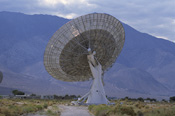
|
|
Satellite TV: Dish antenna

Satellite TV has quickly become the most popular format for home entertainment, outstripping traditional "cable" by offering more modern access to hundreds of channels, broadcast information, and XM Satellite Radio.
There are two major satellite TV providers: Dish Network, and DirecTV. These providers are direct broadcast satellite companies, which means the information they transmit from satellites is intended for homes. Because they use satellites to transmit information directly to homes, it is necessary for satellite TV subscribers to own a satellite dish antenna.
It is not uncommon to drive or walk through a neighborhood and see dish antennas protruding from homes. These satellite dishes are much smaller than in the past, approximately 18" in diameter. In the early 80's a man named Stanley Hubbard founded United States Satellite Broadcasting with the intention of bringing satellite TV to the masses. Over a period of years, while technology advanced, Hubbard approached two major electronics companies with the request to develop a satellite broadcasting service that would provide 175 channels, and to also create small 18" antennas for homes. The electronics companies underwent the expensive task of launching a satellite which came to carry USSB and DirecTV services. In 1998 DirecTV purchased USSB.
|
|
Dish Antennas
When a person subscribes to a satellite TV provider, their satellite system, or package, includes a dish antenna. Dish antennas are necessary to receive satellite TV signals. Usually these antennas range in size from 18" to 36". The majority of antennas are round, but they may also be a variety of shapes and still capable of receiving signals. Unlike many older dish antennas which were motorized to receive a variety of channels with the best reception, modern day dish antennas are fixed in place and do not need to move.
Installing a Dish Antenna
Dish antenna installation is normally provided, hopefully free of charge, by the subscriber's satellite TV provider. Some subscribers may be tempted to bypass a professional installer and set up their dish antenna themselves, especially if there is an installation fee. However, properly setting up a dish antenna that will function as it should is not a simple task, and is best handled by a professional installer. Setting up a dish antenna is not as simple as finding the highest spot on a house or apartment and attaching the dish to that spot. A properly installed dish antenna requires the use of special coordinates, site survey, leveling, routing and running cables, and checking for signal strength, just to name a few tasks.
Normally, the dish antenna is installed on a home's roof or a similar spot free of obstructions. Dish antennas may also be installed at apartments, usually on the balconies. It may be necessary for a homeowner to check local regulations of neighborhood codes regarding the installation of dish antennas.
Dish Antenna Troubleshooting
Although easier to use than older antennas, modern dish antennas are not immune to technical difficulties. Television pictures can black out, freeze, or "pixelate" for a variety of reasons. The most common cause of technical difficulties regarding dish antennas however, is weather. Heavy rains, strong winds, heavy snowfalls, hurricanes, or any severe weather is capable of causing technical problems with a dish antenna. Obstructions are also common causes of dish antenna and viewing problems.
Follow these troubleshooting suggestions to improve the operation of a malfunctioning satellite TV dish antenna. If, after these suggestions fail to produce results, contact the satellite TV provider.
Following Severe Weather:
- After the severe weather has passed, visually check the dish antenna.
- Is the dish still attached to the home?
- Is the dish still in its original position?
- Is there excessive water build-up on the dish
- If excessive water has built-up on the dish antenna following a storm, wipe it off with a soft cloth and spray it with a silicone spray to allow future collections of water to bead off;
- Make sure all other components of the satellite TV system are working properly; a problem may actually be with the satellite receiver or connection;
- Try unplugging the satellite receiver for 15 seconds so it can reset itself;
Obstructions:
- If there has been no severe weather, problems with the picture quality may be due to a dish antenna obstruction. Obstructions can be caused by tree limbs, buildings, or even airplanes flying in certain paths.
- A professional dish installer or maintainer should be called to safely remove the obstruction or realign or relocate the dish to a better spot.
Privacy Policy, Terms of Use